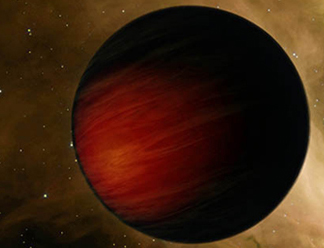Imagine a planet so black that it would appear to be a hole in the sky. If you were approaching TRes-2b in a spaceship, you would see nothing until you were able to discern faint red cracks in the eerie deep black of a hot gas ball one-and-a-half times the size of Jupiter. If you were foolish to fly closer still, you would see that those red cracks are glowing and undulating as they traverse the planet. In an atmosphere as hot as lava, storms whip across this planet at unimaginable speeds.
TRes-2b is known as a “hot Jupiter” because of its proximity to its star, which is more than 700 light years* from Earth in the Cat’s Nebula region of the Milky Way. Whereas Jupiter is around 460 million miles from the Sun, TRes-2b is only 3 million miles from its star, and it has a chemical composition that absorbs heat. Scientists estimate that TRes-2b’s temperature is around 1,885 degrees Kelvin, which is nearly 3,000 degrees Fahrenheit, higher than the melting point of steel and nearly hot enough to melt pure carbon.
TRes-2b reflects less than one percent of its star’s light, making it blacker than coal, blacker than any of the thousands of other exoplanets discovered so far. Why is it so black? It’s not the intense heat. In fact, the heat causes that faint red glow. It is black because TRes-2b is composed of an unusually high mix of sodium, potassium, and titanium oxide, chemicals that absorb light. Sodium vaporizes at 2,669 degrees Fahrenheit and potassium at 1,398 degrees Fahrenheit. Titanium oxide is white at room temperature but turns black as it is heated and releases oxygen. It absorbs UV light, which is why the compound is a primary component of sunscreen. In the furious mix that is TRes-2b’s atmosphere, vaporized sodium, potassium, and titanium oxide absorb heat and light, which makes the planet appear so black.

In contrast, Jupiter’s atmosphere is a blend of hydrogen, helium, and small amounts of methane and ammonia, which reflect light. That’s why we can see Jupiter, but even if we were as close to TRes-2b as we are to Jupiter, we could not see it except through telescopes like the Webb and the Hubble or instruments that detect infrared radiation.
As I noted earlier, TRes-2b is only 3 million miles from its star, but it is orbiting its host at nearly 320,000 miles per hour. It completes one orbit of its sun every 59 hours. If you were to approach TRes-2b in a spaceship, it would whip by you so quickly that it would be no more than a black blur, leaving in its wake a cloud of hot gas. This fiery world is large enough to contain 1,950 Earths and hot enough to vaporize you in an instant. It would be no exaggeration to say that at its speed and temperature, TRes-2b is literally hauling ash.
The universe is so vast and we are so small.
*Light travels approximately 6 trillion miles in a year, so TRes-2b is about 4,200 trillion miles from us, which is a good thing. It would be an awful place to visit.
Photo credits: NASA; Shutterstock: Stock Photo ID: 1205729008